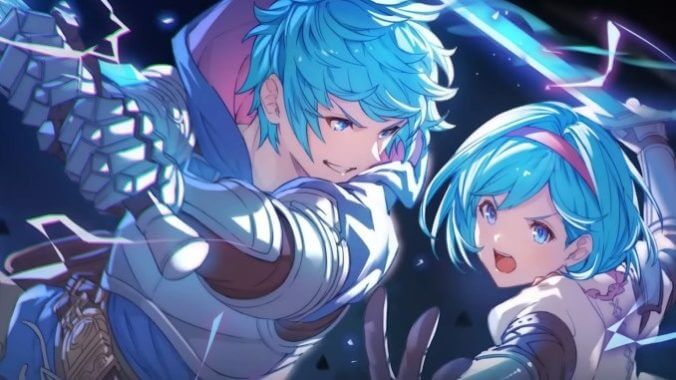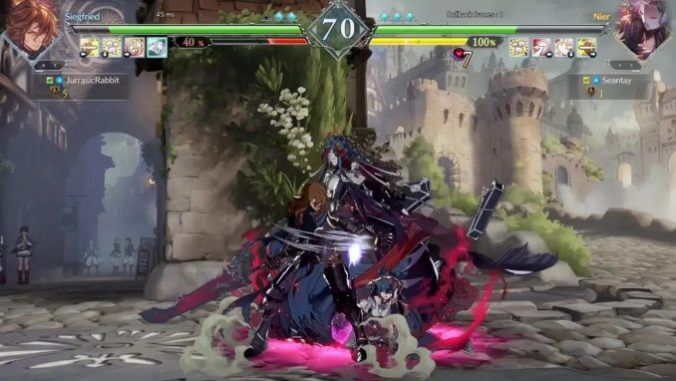Granblue Fantasy Versus: Rising Fixes Its Predecessors’ Biggest Flaw

The exclusion of a single feature more or less undid the 2020 release of Granblue Fantasy Versus. Despite its newcomer-oriented central gameplay, large final roster, and eye-popping 2.5D aesthetic, it lacked something that had recently become industry standard: rollback netcode. For those unfamiliar, rollback netcode can smooth over bumps in internet latency to make online matches feel more consistent, which is a particularly big deal in a genre defined by tight timing. Granblue Fantasy Versus was one of the (seemingly) final major fighting games that didn’t include it, and its online play suffered considerably as a result. And now, three years later, Granblue Fantasy Versus: Rising aims to rectify this.
Rising is a sequel that includes the full roster of the previous entry alongside newcomers, balancing changes, additional mechanics, and, most pivotally, rollback netcode. While it is still a very streamlined rendition of the genre, it combines over-the-top anime shenanigans and more patient Street Fighter-inspired play to create an accessible yet rewarding fighting game. And now it has a functional online experience, so you can enjoy those highs without being forced to face off against someone on the couch.
Like its predecessor, Rising is largely envisioned with genre neophytes in mind. Based on the mobile gacha RPG Granblue Fantasy, this spin-off expects a sizeable chunk of its player base to be fighting game first-timers, which is reflected in its overall design and tutorialization. As for its beginner-oriented flourishes, it features simplified inputs for special attacks (pressing two buttons together instead of using stick motions), auto-combos that let you string blows together while hitting a single button, a guard button to avoid cross-ups (strikes that hit the opposite side of your guard), and includes many characters with straightforward toolkits. It features a three-button layout for normal moves, with light, medium, and heavy attacks corresponding to each button, which is generally easier to wrap your head around than Street Fighter’s six-button setup.
The most obvious benefit of these choices is that dramatically lowering the execution barrier makes it much easier to get to the point where you can experience the tactical push and pull of a match. One of the more daunting elements of fighting games is breaking through the layers of learning and muscle memory to reach a base level of competence where it feels like you’re “actually playing the game.” By reducing these hurdles, Granblue Fantasy Versus: Rising makes it much easier to reach this, ideally hooking novices in the process. It also helps that its tutorials and internal guides are informative and digestible, offering a fairly granular breakdown of its systems. There are plenty of pre-made practice drills that help against common scenarios, combo trials, and character gameplan descriptions that make for a solid introductory course. Between its straightforward core systems and successful onboarding, this is easily one of the most beginner-friendly entries in the space and a great place to start if you’ve wanted to jump into the fold.
That said, many who religiously play fighting games may look at the extensive list of previously mentioned simplifications and worry that this experience is only for fresh faces. Although I have qualms about how auto-combos remove some degree of character expression, wish they had kept the tradeoffs for using simplified inputs from the previous installment, and generally dislike block buttons, I do think there is still enough here for most fellow FGC-heads to have a blast.
For starters, the new systems introduced in this sequel create engaging complexities. One of the more eye-catching additions is Bravery Points, a resource that can be used to perform Raging Strikes, attacks that crush an opponent’s guard or extend combos, and Brave Counters, which can break free of an aggressor’s pressure while blocking. Where things get spicy is that if you run out of points, you’ll take a whopping 50% additional damage. Moreover, hitting foes with supers and raw Raging Strikes lowers the opponent’s points, creating a tug-of-war over resources. This all creates a risk-reward dynamic where you want to spend Bravery Points to use Raging Strikes or break out of opponent block strings, but you don’t want to use too many and leave yourself at risk of getting blown up if you get clipped.

There are plenty of other additions as well, such as dash attacks, which make it much easier to get pressure started, as well as Ultimate Skills, which are powered-up special moves that spend Skybound Gauge and often have some hilariously messed up properties (Siegfried’s unblockable Verdrängen slash left me stunned the first time I saw it). These skills fill in gaps in characters’ toolkits, granting new reversals or other tricky tools you’ll need to look out for. When combined with the last game’s existing mechanics, like the ability to spot dodge or roll, there’s a solid degree of complexity here.
On top of Bravery Points and regular meter, the cooldown system from the previous game acts as an additional resource. Similar to an MMO or MOBA, when you use a special move, like throwing a fireball, there is a cooldown before you can use it again. Where things get interesting is that the strength of the move determines how long this cooldown is, with lighter versions recovering almost instantly while heavier versions have much longer cooldowns. Similar to Bravery Points, there becomes a compelling risk-reward because using heavy versions of your specials leads to more damage and longer combos, but it also means you can’t use them again for a while, forcing you to cycle between different moves during offense. There may be many concessions to get newbies in the door, but these resources and mechanics add enough depth to keep most hardcore players intrigued.
As previously alluded to, Granblue Fantasy Versus: Rising sits in an intersection between two fighting game sub-genres—more “traditional, neutral-based” entries like Street Fighter, and “anime fighters”/ “air dashers” such as Guilty Gear and BlazBlue. Although its visuals align with Arc System Works’ other flashy creations, this game doesn’t have a universal air dash, which tends to increase the pace by allowing players to repeatedly launch their characters like heat-seeking projectiles. By contrast, matches here are generally more deliberate and frequently involve carefully poking opponents with long-range strikes or baiting out jump-ins to land a juicy anti-air. However, there is still a heavy sprinkling of anime absurdity, thanks to a varied cast that ensures every battle feels exciting.
Although there are numerous straightforward characters that follow in the footsteps of the fireball-chucking, dragon punching Ryu, other archetypes are well represented as well. There are fleet-footed rushdown characters, stance wielders, zoners, grapplers, a puppet user, and quite a few oddballs who break the rules. Remember how I said there isn’t an air dash? Grimnir, a wind god, can set orbs that allow him to alter his air trajectory, setting up tricky jump mixups. Similarly, Vira can enter a powered-up state that enables an air dash, and Zeta can repeatedly pogo on her foes to set up delayed overheads. I’ve been sent to another dimension by several Cagliostro masters, who I assume spent many hours in the previous game because they already have intricate block setups that involve side-switching teleports, traps, and tricky frame traps. While its central mechanics lower the execution barrier, even simpler fighting games become complex when facing off against an experienced opponent who understands how to abuse their character’s strengths, and considering the tricky movesets of this cast, there is a lot to learn here. It’s always a good sign when you want to main multiple fighters because they all seem interesting, and I have a long list that I plan on checking out.
